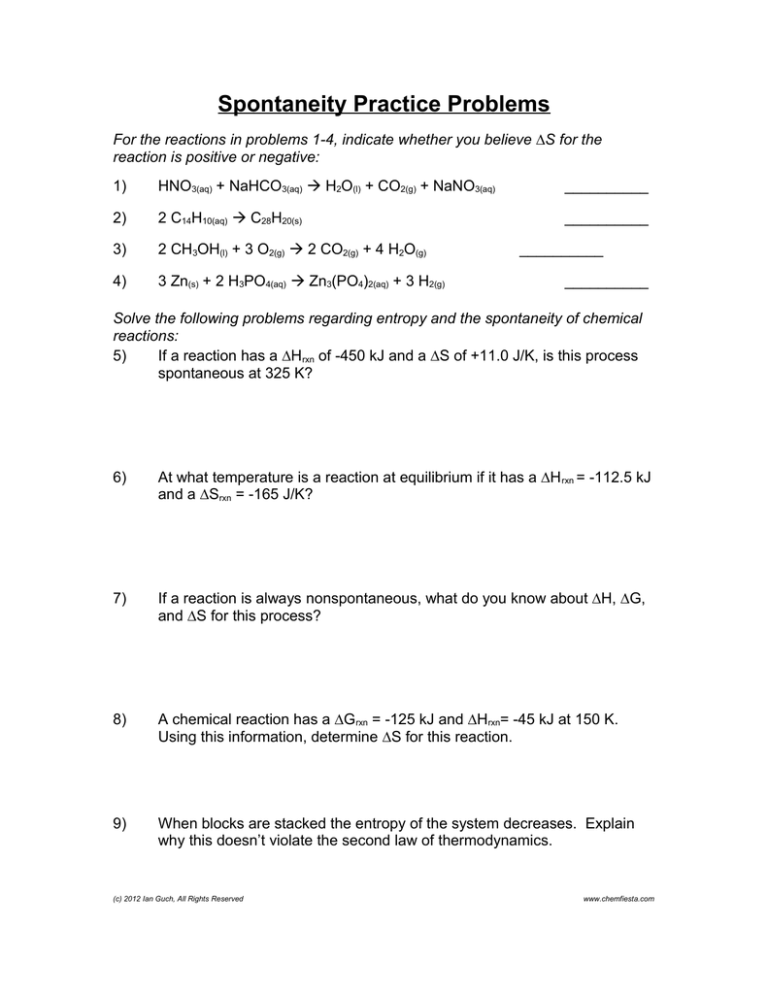
Spontaneity Practice Problems
For the reactions in problems 1-4, indicate whether you believe ∆S for the
reaction is positive or negative:
1)
HNO3(aq) + NaHCO3(aq) H2O(l) + CO2(g) + NaNO3(aq)
__________
2)
2 C14H10(aq) C28H20(s)
__________
3)
2 CH3OH(l) + 3 O2(g) 2 CO2(g) + 4 H2O(g)
4)
3 Zn(s) + 2 H3PO4(aq) Zn3(PO4)2(aq) + 3 H2(g)
__________
__________
Solve the following problems regarding entropy and the spontaneity of chemical
reactions:
5)
If a reaction has a ∆Hrxn of -450 kJ and a ∆S of +11.0 J/K, is this process
spontaneous at 325 K?
6)
At what temperature is a reaction at equilibrium if it has a ∆H rxn = -112.5 kJ
and a ∆Srxn = -165 J/K?
7)
If a reaction is always nonspontaneous, what do you know about ∆H, ∆G,
and ∆S for this process?
8)
A chemical reaction has a ∆G rxn = -125 kJ and ∆Hrxn= -45 kJ at 150 K.
Using this information, determine ∆S for this reaction.
9)
When blocks are stacked the entropy of the system decreases. Explain
why this doesn’t violate the second law of thermodynamics.
(c) 2012 Ian Guch, All Rights Reserved
www.chemfiesta.com
Spontaneity Practice Problems Answers
For the reactions in problems 1-4, indicate whether you believe ∆S for the
reaction is positive or negative:
1)
HNO3(aq) + NaHCO3(aq) H2O(l) + CO2(g) + NaNO3(aq)
+
2)
2 C14H10(aq) C28H20(s)
-
3)
2 CH3OH(l) + 3 O2(g) 2 CO2(g) + 4 H2O(g)
+
4)
3 Zn(s) + 2 H3PO4(aq) Zn3(PO4)2(aq) + 3 H2(g)
+
Solve the following problems regarding entropy and the spontaneity of chemical
reactions:
5)
If a reaction has a ∆Hrxn of -450 kJ and a ∆S of +11.0 J/K, is this process
spontaneous at 325 K?
Yes, if ∆H is – and ∆S is +, the reaction is spontaneous at all
temperatures.
6)
At what temperature is a reaction at equilibrium if it has a ∆H rxn = -112.5 kJ
and a ∆Srxn = -165 J/K?
682 k
7)
If a reaction is always nonspontaneous, what do you know about ∆H, ∆G,
and ∆S for this process?
∆H = +, ∆G = +, ∆S = -
8)
A chemical reaction has a ∆G rxn = -125 kJ and ∆Hrxn= -45 kJ at 150 K.
Using this information, determine ∆S for this reaction.
∆S = 533 J/K
9)
When blocks are stacked the entropy of the system decreases. Explain
why this doesn’t violate the second law of thermodynamics.
No, because the entropy of the universe still increases.
(c) 2012 Ian Guch, All Rights Reserved
www.chemfiesta.com



